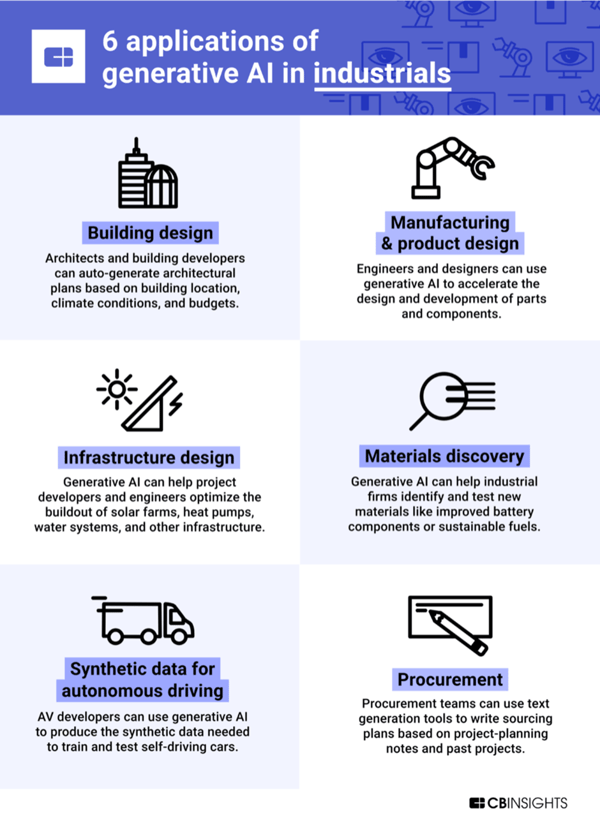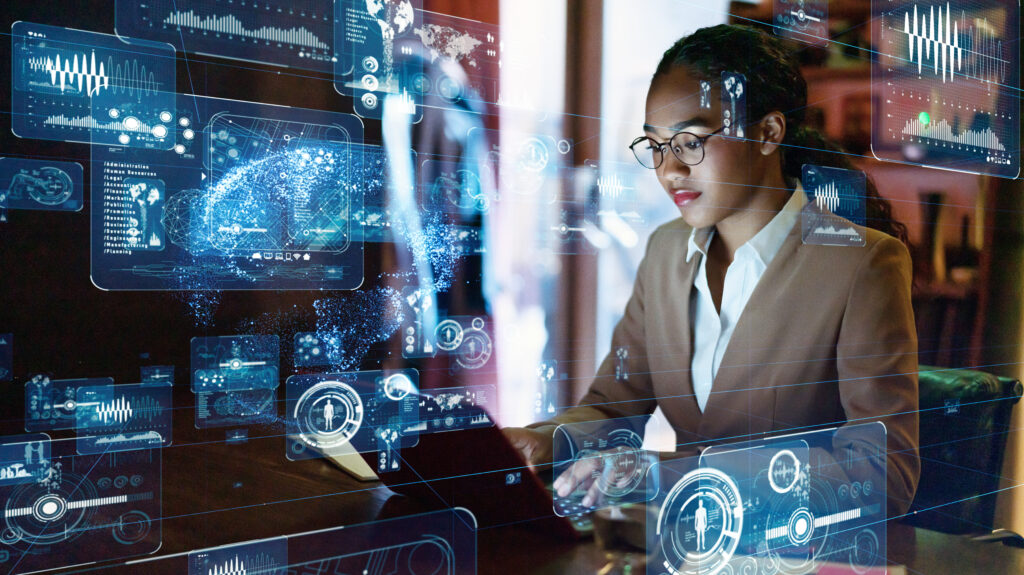Since its debut in November 2022, generative artificial intelligence has taken center stage on the business agenda.
Generative AI refers to a major category of artificial intelligence responsible for content creation. It has caused significant disruption to various industries, especially the labor sector.
In contrast to typical AI, which relies on specific sets of rules, generative AI relies on GPT, one of the machine learning (ML) models that helps it create content autonomously. These models use vast amounts of data to predict the patterns, nuances, and context of human language.
According to Goldman Sachs, Generative AI will eventually automate 300 million jobs. With that in mind, read on to learn how artificial intelligence will impact the future of work.
Generative artificial intelligence and traditional artificial intelligence
Generative artificial intelligence is a new thing and somewhat unfamiliar to many people. Therefore, artificial intelligence and generative artificial intelligence are often confused. In some cases, some people believe that generative AI is superior to traditional AI.
First, the main purpose of traditional artificial intelligence is to evaluate and interpret complex patterns and data for human understanding. But when it comes to generating artificial intelligence, it goes a step further. By using the data we provide it, it can create new content for us to use.
It is more popular when innovation and creation works. In the architecture and design industries, it has become a popular tool among professionals in these fields.
Generative AI has huge potential, but even so, traditional AI still has a place now and in the future. Traditional artificial intelligence comes in handy when it comes to research and precision in the workplace. Therefore, neither tool can operate independently.
However, generative AI requires the capabilities of traditional AI to operate effectively. Therefore, traditional artificial intelligence remains center stage for automation solutions built to facilitate operations.
Where to apply generative artificial intelligence at work
As a source of innovation and empowerment for creative professionals, generative AI is a tool preferred over traditional tools.
You can use it to solve problems and create in different fields, and it is currently being practiced in these industries.

source: CBINSIGHTS
Art & Music
Traditional AI and generative AI can work together to create something new using existing music and art.
These tools allow you to push traditional boundaries to inspire.
Virtual assistants and productivity tools
With the help of generated artificial intelligence, you can delegate some tasks to a virtual assistant. While AI handles repetitive tasks, you can focus on important issues like task management, scheduling, and personalized assistance.
health diagnosis
Artificial intelligence can be very resourceful in healthcare, especially in the area of diagnostics. Some generative AI models can capture, evaluate and translate diagnostic reports. They can also help medical professionals identify anomalies or patterns in patient data.
Healthcare professionals can leverage generative AI to create accurate diagnostic reports while reducing the time required for analysis.
Enhance decision-making skills
Generative AI can help you make informed decisions in your business because it uses data to provide predictions and insights.
If you’re in the healthcare or financial industries, this tool can provide more accurate forecasts. Your margin of error shrinks significantly.
Supply chain optimization
Maintaining customer trust and building a strong track record in supply chain operations has never been easy, but generative artificial intelligence in this area is proven to ease the burden.
With its predictive and analytical capabilities, businesses can optimize inventory and meet customer demand.
The tool can also help identify frustrations in the process and provide guidance for improvement. All this is possible through the analysis of past data.
Fraud detection
Detecting fraud is an important aspect of many financial careers, but it’s not a simple task.
Generative AI’s ability to analyze large amounts of data and provide accurate insights can be an excellent resource for this endeavor. This means financial professionals can more easily detect fraud patterns and develop effective solutions to protect their systems.
Internet security
Generative AI can enhance network security measures and evaluate network traffic patterns to identify anomalies that require attention. Additionally, it can spot potential threats and provide viable defenses.
Human Resources (HR) and Recruitment
Managing HR processes and employee recruitment presents a unique set of challenges, but when you bring generative artificial intelligence into the process, the likelihood of overcoming them increases.
The tool uses a candidate’s data, cross-checks it, and identifies the ideal match for the open position. That’s why HR builds winning teams. Additionally, you can reduce the time wastage that typically occurs during the recruitment process.
Data analysis and insights
Generative AI can help identify patterns and predict trends.
It is faster and can handle large data sets. For example, marketers use generative AI to identify reliable media contacts.
Language translation, learning and localization
Global enterprises must integrate generative AI into their language translation, learning and localization workflows.
With this tool, businesses can maintain accurate and culturally appropriate communications.
source: crush farm
Organizations can also use it to develop customized and immersion learning programs for those interested in foreign language education. What’s more, generative AI can simulate real-world conversations. Therefore, learners have better opportunities to practice.
Finally, when students have a customized study plan, their chances of success are higher. They gain greater control over their time and gain the confidence to complete their plans.
Customized marketing
Marketers can use generative AI to customize strategies to fit their customer profiles. They can collect and evaluate customer data to customize marketing campaigns, product recommendations and advertising.
Generative AI can also build Press release Make them more effective.
customer service
Customer service is another area of business that requires a lot of manpower. But through generative AI, agents can shift this work to other important areas of the business.
They can also be set up to generate artificial intelligence to develop chatbots that handle customer inquiries.
Code generation and programming
Developers can use generative artificial intelligence to generate code and fix bugs. With your engineering skills and artificial intelligence capabilities, teams can improve workflows.
Creativity and Design
Generative AI supports a variety of functions. It helps designers with graphics, creative brainstorming, or layout suggestions.
The tool can inspire creatives to automate certain processes and generate design variations. As a result, prototype turnaround times are shorter than normal. Customers can even choose different versions of the design.
How to get help when introducing artificial intelligence into the workplace
Introducing generative AI into the workplace presents unique challenges that need to be navigated carefully.
As a change process, organizations must obtain professional assistance for successful integration. These are ideal places to get help.
Artificial Intelligence Consulting Company
Artificial Intelligence Consultants have the expertise to help businesses successfully establish generative AI practices. Even better, they can also assist with employee training.
Government and industry initiatives
There are government and industry-led schemes to help businesses adopt this technology.
Depending on the region, organizations may be able to find resources, subsidies, and grants that can support implementation of this tool.
Internal training program
Internal training programs can help employees fill knowledge gaps and ensure everyone has the same information on how to use it.
How to meet the challenges of generative AI in business
While generative AI can be an important resource, ethical aspects must be considered among other potential pitfalls. Here are some ways to deal with the challenges that come with it.
investment training
Generative AI is more than just taking it and putting it to use. For accuracy, reliable data and less bias, trained people are needed at the helm. Training employees how to use the tool improves their chances of achieving desired results.
Develop policies
Policies help govern the use of this tool. Therefore, leadership must establish rules and regulations regarding its use.
Educate employees on ethical implications
Educating employees about the implications is critical to ensuring employees do not cross any ethical lines.
Lack of training on the potential impacts of using this tool sets workers up for failure. Additionally, businesses can form a team to ensure everyone adheres to ethical guidelines.
Continuously monitor performance
Having a team that continuously monitors the generated artificial intelligence is critical.
Through evaluation, leaders can determine whether tools are working accurately. They can also improve performance by making adjustments when necessary.
Invest time in data verification
Organizations must not rush to trust data from generative AI without double-checking verification.
It relies on available data to provide results, so sometimes the information it provides is inaccurate. But with a data verification system, companies no longer have to worry. This system only provides accurate, high-quality, and up-to-date information.
Disadvantages and challenges of generative artificial intelligence
Of course, this tool promises huge benefits, but even so, it comes with its fair share of frustrations that you need to consider.
Let’s take a look at some of them.
Moral issue
This is one of the main concerns about artificial intelligence in general. To provide results, the tool relies on existing data sets.
Therefore, copyright infringement becomes an issue. People can also use this tool to generate fake news, deepfakes, and spread misinformation. All of this can have real-world consequences.
data privacy
Generally speaking, even experts cannot control access to data generated by artificial intelligence, and it is even harder to regulate who can use the tool’s data.
Because of this, data privacy has become a significant issue. This also means that personal data is at risk because the tool can quickly obtain personal data.
Data-driven bias
Generative AI relies on existing data to produce results. If the existing data is consistently inaccurate, the tool’s end result will deliver inaccurate information.
maintain
Despite its immense intelligence, generative AI is like any other digital solution. It requires constant maintenance and regular updates.
Less control over output
The results of generative AI can be unpredictable. Therefore, human intervention remains critical to the final outcome.
The impact of artificial intelligence on work
Artificial intelligence has an important influence in various industries. As adoption continues across sectors, it is bound to impact the future of work.
The impact of this tool is both positive and negative. On the positive side, it makes work easier through automation and aids decision-making. Not to mention, it’s a powerful solution when it comes to virtual security.
On the negative side, these tools could displace millions of jobs that could be automated. By harnessing the power of generative artificial intelligence, you (an individual or organization) can navigate the future with confidence.
Dig deeper into the ethics of artificial intelligence and read 4 essential questions we should ask to gain important insights.
Edited by Aisha West
